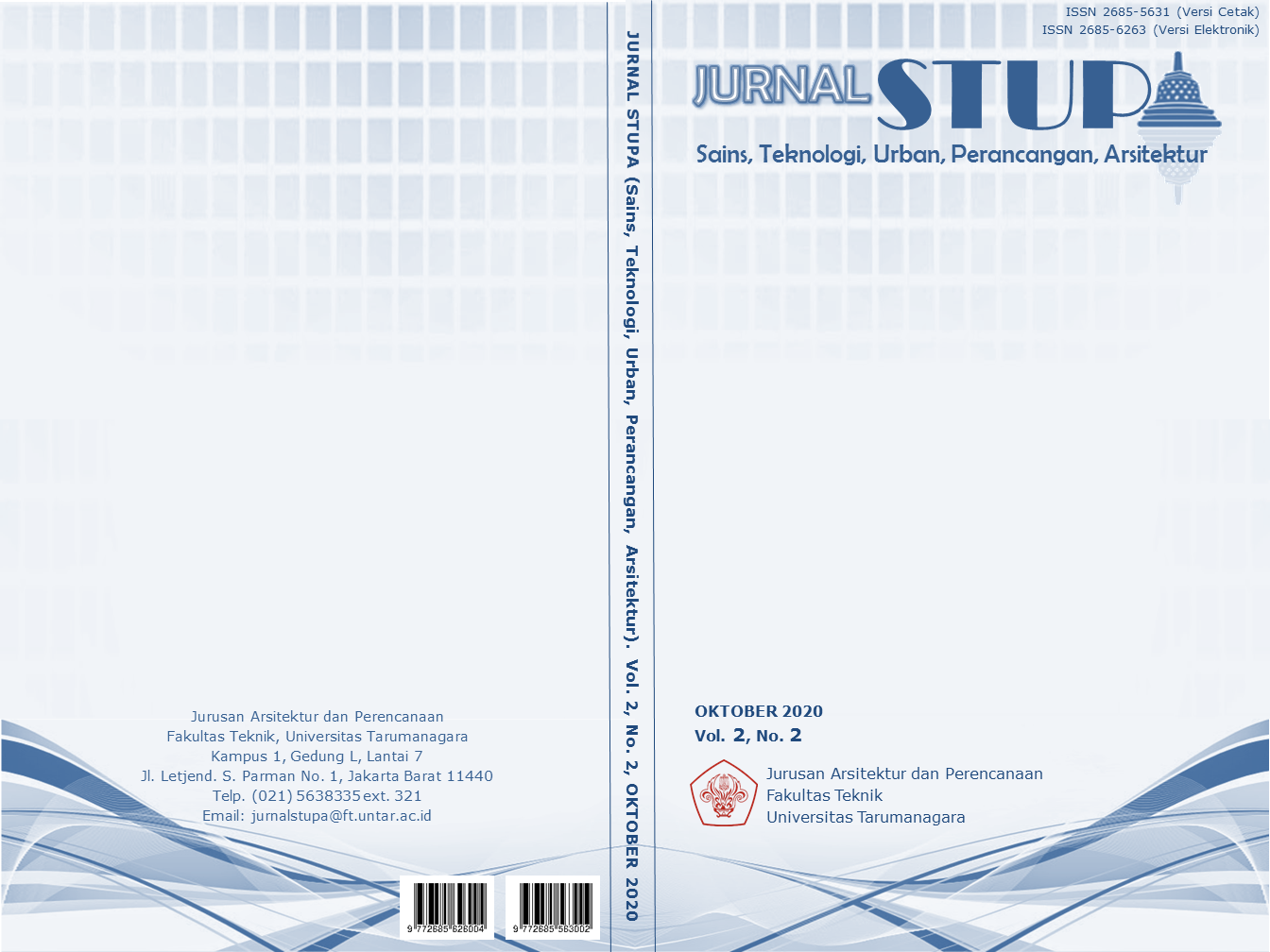FENOMENOLOGI SEBAGAI METODE PENGEMBANGAN EMPATI DALAM ARSITEKTUR
Main Article Content
Abstract
Along with the times, humans gradually growing too. This different time which is the main holder of changes in human nature that unconsciously causing many things, like in social terms. Technology, economy, knowledge, safety, social level, and place become a factor that affect human’s social changes. These social changes can refer to individualistic and do not care about the surrounding environment, so empathy seems to never be heard agin in this era, especially in urban. Empathy includes the ability to feel the emotional statre of others, feel sympathetic and try to slove problems, and take other people’s perspective (Baron & Byrne, 2004),. While the fact from recent studies have shown that empathy in a person is becoming increasingly rare, as many as 65 percent of people do not care or lose empathy (Daily Mail, 2019). Though empathy itself is important according to Graaff et al (2014) where empathy which underlines the importance of ability, behavior and a very important role in the development of moral and prosocial. The reduced level of empathy in urban is a major factor for designers to design a Pegadungan Empathy Development a place that can maintain and develop empathy through the phemomenology approach using human senses, as a training to feel the emotions of others through architectural space, one of them by labyrinth. The method project from Juhani Pallasmaa theories “An Architecture of Seven Sense” and “The Eyes of The Skin: Architecture and Sense” and through data collection from DKI Jakarta BPS, scientific journals, e-books, survey, interview and questionnaires, and local society needs analysis. With this, this project expected that empathy can be felt and maintained at any time, with a design in accordance with the characteristic of empathy.
Keywords: empathy; labyrinth; Pegadungan; phenomenology; sense
Abstrak
Seiring perkembangan zaman, manusia semakin berkembang pula. Perubahan sifat manusia menjadi pemegang kunci utama yang tanpa disadari menimbulkan salah satunya dalam hal sosial. Teknologi, ekonomi, pengetahuan, keamanan, tingkat sosial, dan tempat menjadi faktor yang mempengaruhi perubahan sosial manusia. Perubahan sosial tersebut seperti manusia yang individualis dan tidak peduli terhadap lingkungan sekitar, sehingga kata empati seakan tidak ada saat ini, terutama di daerah perkotaan. Empati termasuk kemampuan untuk merasakan keadaan emosional orang lain, merasa simpatik dan mencoba menyelesaikan masalah, dan mengambil perspektif orang lain (Baron & Byrne, 2004). Faktanya, studi terbaru menunjukan rasa empati dalam diri seseorang semakin langka, sebanyak 65% orang bersikap tidak peduli atau kehilangan empati (Daily mail, 2019). Padahal empati merupakan hal penting menurut Graaff dkk, (2014), empatilah yang menggaris bawahi pentingnya kemampuan, tingkah laku dan sebuah peran yang sangat penting dalam pengembangan moral dan perilaku prososial. Menurutnya tingkat empati masyarakat di kota besar menjadi faktor utama bagi perancang untuk merancang sebuah Wadah Pengembangan Empati Pegadungan yang dapat menjaga maupun mengembangkan rasa empati tersebut melalui pendekatan fenomenologi indera manusia, sebagai wadah pelatihan untuk merasakan emosi sesama melalui ruang arsitektur, salah satunya pada labirin. Proyek ini menggunakan metode dari teori Juhani Pallasmaa “An architecture of seven sense” dan “The eyes of the skin: architecture and sense” dan melalui pengumpulan data dari BPS DKI Jakarta, jurnal ilmiah, e-book, survei, wawancara dan kuisioner, serta analisis kebutuhan masyarakat sekitar. Dengan ini diharapkan rasa empati tetap terasa dan terjaga sampai kapanpun, dengan desain sesuai dengan karakteristik empati.
Article Details
References
Aoun, R. G. (2016). Emotional Design in Architecture. Retrieved June 24, 2020, from https://www.brikbase.org/sites/default/files/2016-09-16%20ANFA%20Conference%20Abstract_03.pdf
Baron & Byrne. (2004). Psikologi sosial jilid 2. Jakarta: Erlangga.
Droog, S dan Paul de V. (2009). Emotion in architecture: The experience of the user.
Goleman, D. (1996). Kecerdasan emosional. Jakarta: PT. Gramedia Pustaka Utama.
Goleman, D. (2007). Kecerdasan emosi untuk mencapai puncak prestasi. Jakarta: PT. Gramedia Pustaka Utama.
Hodiono, R. (2016). Hubungan Antara Pola Asuh Otoriter Orang Tua Dengan Empati Pada Remaja Awal. Skripsi thesis, Universitas Mercu Buana Yogyakarta.
Hoffman, M. L. (2000). Empathy and moral development: Implications of caring and justice. New York: Cambridge University Press.
https://issuu.com/pauldevries/docs/20090202_emotioninarchitecture_big
Janehall, S. (2008). Enchanting well-being: A multisensory interior environmental experience: An application of Juhani Pallasmaa’s theory of architecture to interior space. Thesis. Washington D.C.: Washington State University.
Pallasmaa, J. (2005). The eyes of the skin : Architecture and sense. Cornwall, Great Britain : TJ International Ltd. Padstow.
Pallasmaa, J., Holl, S., Perez-Gomez, A.. (1994). An architecture of seven sense: Architecture and urbanism question of perception. Tokyo: A+u Publishing.
Rossa, V. (2020). Studi: 65 Persen Orang Kehilangan Rasa Empati. Diakses 24 Juni 2020, dari https://www.suara.com/lifestyle/2019/04/23/161121/studi-65-persen-orang-kehilangan-rasa-empati.
Sabatini, S. N. (2017). Sumbangsih Juhani Pallasmaa dalam Teori Arsitektur. Jurnal RUAS, 15(2). ISSN 1693-3702.
Van der Graaff, J., Branje, S., De Wied, M., Hawk, S., Van Lier, P., &
Meeus, W. (2014). Perspective Taking and Empathic Concern in Adolescence: Gender Differences in Developmental Changes. Developmental Psychology,50(3)



